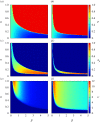Escaping the tragedy of the commons through targeted punishment - PubMed (original) (raw)
. 2015 Aug 26;2(8):150223.
doi: 10.1098/rsos.150223. eCollection 2015 Aug.
Affiliations
- PMID: 26361551
- PMCID: PMC4555856
- DOI: 10.1098/rsos.150223
Escaping the tragedy of the commons through targeted punishment
Samuel Johnson. R Soc Open Sci. 2015.
Abstract
Failures of cooperation cause many of society's gravest problems. It is well known that cooperation among many players faced with a social dilemma can be maintained thanks to the possibility of punishment, but achieving the initial state of widespread cooperation is often much more difficult. We show here that there exist strategies of 'targeted punishment' whereby a small number of punishers can shift a population of defectors into a state of global cooperation. We conclude by outlining how the international community could use a strategy of this kind to combat climate change.
Keywords: climate change; cooperation; social dilemma.
Figures
Figure 1.
(a) Stationary proportion of cooperators, ρ, for a range of rationality, β, and punishment, π, from Monte Carlo simulations of the model when all cooperators punish all defectors, and initially all _N_=200 players cooperate. (Results are the averages over 100 realizations.) (b) As before, but now all players initially defect. (c) Fixed points of the dynamics against β, when _π_=0.4; stable fixed points are depicted in red, unstable ones in blue. (d) As in (c), but with _π_=0.6. (e) Fixed points of the dynamics against π, when _β_=2.5. (The fixed-point analysis is described in Methods.)
Figure 2.
Diagrams illustrating the two strategies of targeted punishment described in the main text: (a) the ‘single file strategy’ and (b) the ‘groups strategy’ with groups of size _ν_=3 and a threshold _θ_=2/3. Players are arranged from most to least inherently cooperative; those currently cooperating are shown in red and those defecting in blue. A black arrow indicates a defector who is considered at fault (and therefore liable to be punished) according to the strategy, while a grey arrow signals a cooperator who would be at fault if she were defecting.
Figure 3.
(a) As figure 1_b_ (all players initially defect), but now the ‘single file strategy’ is applied. (b) As in figure 1_b_, but under the ‘groups strategy’ with ν_=10 and θ_=80%. (See the main text and figure 2 for descriptions of these strategies.) (c) Difference between figure 1_a (all players initially cooperate) and figure 3_a. (d) Difference between figures 1_a_ and 3_b_. (e) Speed v_=N/τ, where τ is the number of time steps required to achieve global cooperation, for the situation in figure 3_a. (f) Speed v for the case of figure 3_b_.
Similar articles
- When is altruistic punishment useful in social dilemmas?
Greenwood GW, Abbass HA, Petraki E. Greenwood GW, et al. Biosystems. 2018 Dec;174:60-62. doi: 10.1016/j.biosystems.2018.10.015. Epub 2018 Nov 2. Biosystems. 2018. PMID: 30391264 - Evolution of cooperation in a hierarchical society with corruption control.
Huang F, Chen X, Wang L. Huang F, et al. J Theor Biol. 2018 Jul 14;449:60-72. doi: 10.1016/j.jtbi.2018.04.018. Epub 2018 Apr 13. J Theor Biol. 2018. PMID: 29660418 - The evolution of anti-social rewarding and its countermeasures in public goods games.
dos Santos M. dos Santos M. Proc Biol Sci. 2015 Jan 7;282(1798):20141994. doi: 10.1098/rspb.2014.1994. Proc Biol Sci. 2015. PMID: 25429015 Free PMC article. - On the interaction of the stick and the carrot in social dilemmas.
Milinski M, Rockenbach B. Milinski M, et al. J Theor Biol. 2012 Apr 21;299:139-43. doi: 10.1016/j.jtbi.2011.03.014. Epub 2011 Mar 31. J Theor Biol. 2012. PMID: 21458464 Review. - Punishment and cooperation in nature.
Raihani NJ, Thornton A, Bshary R. Raihani NJ, et al. Trends Ecol Evol. 2012 May;27(5):288-95. doi: 10.1016/j.tree.2011.12.004. Epub 2012 Jan 25. Trends Ecol Evol. 2012. PMID: 22284810 Review.
Cited by
- Punishment and inspection for governing the commons in a feedback-evolving game.
Chen X, Szolnoki A. Chen X, et al. PLoS Comput Biol. 2018 Jul 20;14(7):e1006347. doi: 10.1371/journal.pcbi.1006347. eCollection 2018 Jul. PLoS Comput Biol. 2018. PMID: 30028836 Free PMC article. - The global network of ports supporting high seas fishing.
Rodríguez JP, Fernández-Gracia J, Duarte CM, Irigoien X, Eguíluz VM. Rodríguez JP, et al. Sci Adv. 2021 Feb 26;7(9):eabe3470. doi: 10.1126/sciadv.abe3470. Print 2021 Feb. Sci Adv. 2021. PMID: 33637531 Free PMC article. - Sustainability is possible despite greed - Exploring the nexus between profitability and sustainability in common pool resource systems.
Osten FBV, Kirley M, Miller T. Osten FBV, et al. Sci Rep. 2017 May 23;7(1):2307. doi: 10.1038/s41598-017-02151-y. Sci Rep. 2017. PMID: 28536450 Free PMC article. - The paradigm of tax-reward and tax-punishment strategies in the advancement of public resource management dynamics.
Wang L, Liu Y, Guo R, Zhang L, Liu L, Hua S. Wang L, et al. Proc Biol Sci. 2024 Jun;291(2024):20240182. doi: 10.1098/rspb.2024.0182. Epub 2024 Jun 12. Proc Biol Sci. 2024. PMID: 38864335 Free PMC article.
References
- Arrhenius S. 1896. On the influence of carbonic acid in the air upon the temperature of the ground. Phil. Mag. 41, 237–276. (doi:10.1080/14786449608620846) - DOI
- Siegenthaler U et al. 2005. Stable carbon cycle–climate relationship during the late pleistocene. Science 310, 1313–1317. (doi:10.1126/science.1120130) - DOI - PubMed
- Kunzig R. 2013. Climate milestone: earth's CO2 level passes 400 ppm. Washington, DC: National Geographic.
- IPCC. 2013. Summary for policymakers, book section SPM, pp. 1–30. Cambridge, UK: Cambridge University Press.
- Pacheco JM, Vasconcelos VV, Santos FC. 2014. Climate change governance, cooperation and self-organization. Phys. Life Rev. 11, 573–586. (doi:10.1016/j.plrev.2014.02.003) - DOI - PubMed
LinkOut - more resources
Full Text Sources
Other Literature Sources


